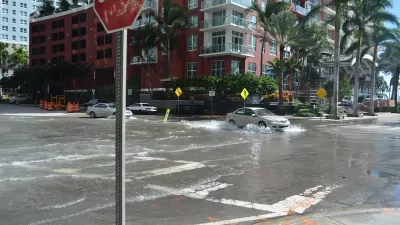After four years of political wrangling, hundreds of public and internal meetings, several revisions, and one determined planning department, consultant team, and Mayor, the City of Miami made urban planning history tonight by adopting the largest known application of a form-based code. In doing so, Miami has catapulted itself to the forefront of those large American cities serious about implementing smart growth.
After four years of political wrangling, hundreds of public and internal meetings, several revisions, and one determined planning department, consultant team, and Mayor, the City of Miami made urban planning history tonight by adopting the largest known application of a form-based code. In doing so, Miami has catapulted itself to the forefront of those large American cities serious about implementing smart growth.
To be sure, certain elements of the code remained controversial, such as a 35 foot height limit proposed--and adopted-- for a large stretch of the city's most important corridor, yet City Commissioners admirably managed to vote 4-1 in favor of officially replacing the city's outmoded use-base zoning code with a form-based code. Interestingly, Sandy Sorlien, a form-based code expert, also reports that the small town of Jamestown, Rhode Island adopted a form-based code this evening.
While dozens of lessons may now be learned from the Miami 21 process, a few other large cities are already ready to ditch their own sprawl inducing codes for a more sustainable pattern of growth. Denver, for example, will likely adopt its own comprehensive form-based code in a matter of months.
Miami 21 is not perfect, but its implementation will allow all practicing planners and advocates of form-based codes alike to study and learn from the successes and failures of Miami's process and eventual results. For that, I hope you can join me in congratulating the City of Miami (and Jamestown) for taking a bold step forward in pursuing a more sustainable 21st century American city.

Alabama: Trump Terminates Settlements for Black Communities Harmed By Raw Sewage
Trump deemed the landmark civil rights agreement “illegal DEI and environmental justice policy.”

Planetizen Federal Action Tracker
A weekly monitor of how Trump’s orders and actions are impacting planners and planning in America.

The 120 Year Old Tiny Home Villages That Sheltered San Francisco’s Earthquake Refugees
More than a century ago, San Francisco mobilized to house thousands of residents displaced by the 1906 earthquake. Could their strategy offer a model for the present?

Ken Jennings Launches Transit Web Series
The Jeopardy champ wants you to ride public transit.

BLM To Rescind Public Lands Rule
The change will downgrade conservation, once again putting federal land at risk for mining and other extractive uses.

Indy Neighborhood Group Builds Temporary Multi-Use Path
Community members, aided in part by funding from the city, repurposed a vehicle lane to create a protected bike and pedestrian path for the summer season.
Urban Design for Planners 1: Software Tools
This six-course series explores essential urban design concepts using open source software and equips planners with the tools they need to participate fully in the urban design process.
Planning for Universal Design
Learn the tools for implementing Universal Design in planning regulations.
Clanton & Associates, Inc.
Jessamine County Fiscal Court
Institute for Housing and Urban Development Studies (IHS)
City of Grandview
Harvard GSD Executive Education
Toledo-Lucas County Plan Commissions
Salt Lake City
NYU Wagner Graduate School of Public Service




























